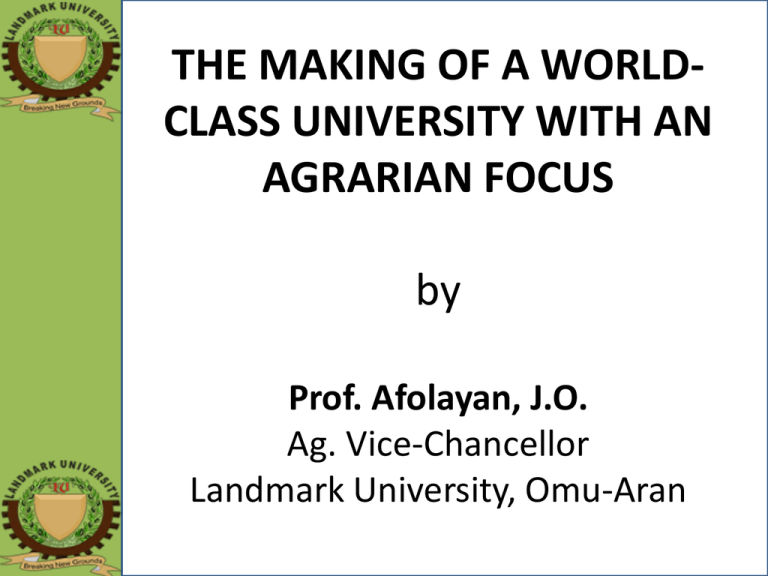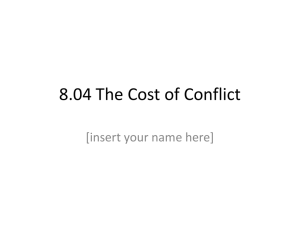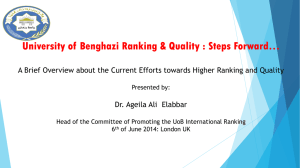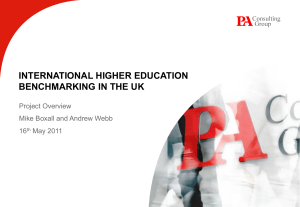The Making of a World-Class University.
advertisement

THE MAKING OF A WORLDCLASS UNIVERSITY WITH AN AGRARIAN FOCUS by Prof. Afolayan, J.O. Ag. Vice-Chancellor Landmark University, Omu-Aran HIGHLIGHTS • The Concept of a University • The So-Called World Class Universities • The Ranking Systems of World Universities and their Parameters • The Strides of Landmark University (LU) • The 2014/2015 Strategic Pursuit of LU • Concluding Remarks THE CONCEPT OF A UNIVERSITY Meaning • An institution of higher education having authority to award bachelors' and higher degrees, usually having research facilities. (British Dictionary) • A university may be modeled as a city, or indeed as a state, with all the stuff and intricacies attendant on a state. • A university is constantly in a race for global relevance and drives a system that is wholesome, competitive and futuristic. (Njoku, 2008) Functions • • • • Teaching Research Community impact Driving of enterprises Expectations Due to globalisation, universities are to be: - Vital sources of new knowledge and innovative thinking - Providers of skilled personnel with credible credentials - Contributors to innovations Expectations cont’d - Attractors of international talents and business investment - Agents of social justice and mobility - Contributors to social and cultural vitality THE SO-CALLED WORLD-CLASS UNIVERSITIES (WCU) • A World-Class University has been described as an elitist state that is conferred based on international recognition by an external community (Salmi, 2009). Key features of WCU (Salmi and Tremblay, 2000): • High concentration of talents (faculty and students) • Abundant learning and research resources • Favourable governance The dynamic interaction of the key features constitutes the characteristics of highranking universities (see Figure 1) Figure 1: Alignment of Key Features of a WCU (Source: Salmi, 2009) Other Expectations from WCU • commitment to breadth and excellence in all fields of human inquiry • engage in cutting-edge research whilst at the same time teaching the next generation, their students • allow their researchers the freedom to experiment, succeed, and sometimes fail • have permeable boundaries. This means encouraging interdisciplinary research and teaching THE RANKING SYSTEMS OF WORLD UNIVERSITIES AND THEIR PARAMETERS – Times Higher Education (THE) Ranking – Academic Ranking of World Universities – Webometrics Ranking – Professional Ranking of World Universities – Newsweek Ranking, and – Others Ranking Parameters Times Higher Education (THE) World University Ranking The grouped performance indicators: – Teaching: the learning environment (30%) – Research: volume, income and reputation (30%) – Citations: research influence (30%) – Industry income: innovation (2.5%) – International outlook: staff, students and research (7.5%). Scope of ranking Universities are excluded from Rankings, if: • they do not teach undergraduates; • they teach only a single narrow subject; or • their research output amounted to fewer than 1,000 articles between 5 years (i.e., 200/year). • In some exceptional cases, institutions that are below the 200-paper threshold are included if they have a particular focus on disciplines with generally low publication volumes, such as engineering or the arts and humanities. Research: Volume, income, reputation (30%) • This category is made up of three indicators. – Reputation for research excellence among its peers – 18% – University research income, scaled against staff numbers – 6% – Research productivity – the number of papers published in the academic journals indexed by Thomson Reuters per academic – 6% Citations: Research influence (30%) – It is the single most influential of the 13 indicators, and looks at the role of universities in spreading new knowledge and ideas. – We examine research influence by capturing the number of times a university's published work is cited by scholars globally. Industry income: Innovation (2.5%) • A university's ability to help industry with innovations, inventions and consultancy has become a core mission of the contemporary global academy. • This category seeks to capture such "knowledge transfer" by looking at how much research income an institution earns from industry, scaled against the number of academic staff it employs. Teaching: The learning environment (30%) – This category employs five separate performance indicators designed to provide a clear sense of the teaching and learning environment of each institution from both the students and the academic perspective. – The dominant indicator here uses the results of the world's largest invitationonly academic reputation survey. – The teaching category also examines the ratio of doctoral to bachelor's degrees awarded by each institution. – We believe that institutions with a high density of research students are more knowledge-intensive and that the presence of an active postgraduate community is a marker of a research-led teaching environment valued by undergraduates and postgraduates alike. International outlook: People, research (7.5%) – This category looks at diversity on campus and to what degree do academics collaborate with international colleagues on research projects - both show how global an institution is in its outlook. The Academic Ranking Universities (ARWU) of World • This is compilation by the Shanghai Jiao Tong University that is being maintained by the Shanghai Ranking Consultancy. • The ranking is funded by the Chinese government with an initial purpose of measuring the gap between Chinese and "world class" universities. • The ranking criteria are as follow: Webometrics Ranking The Ranking Web or Webometrics is the largest academic ranking of Higher Education Institutions. Since 2004 and every six months an independent, objective, free, open scientific exercise is performed by the Cybermetrics Lab (Spanish National Research Council, CSIC). • The four ranking indicators include: - Size (S). Number of pages recovered from four engines: Google, Yahoo, and Bing Search. - Visibility (V). The total number of unique external links received (inlinks) by a site, according to Yahoo Site Explorer. - Rich Files (R). Academic and publication activities and the volume of the different file formats: Adobe Acrobat (.pdf), Adobe PostScript (.ps), Microsoft Word (.doc) and Microsoft Powerpoint (.ppt). These data were extracted using Google, Yahoo and Bing. - Scholar (Sc). Items published in Google Scholar and the SIR – SCImago Institutional Ranking. LANDMARK LAND-MARKING STRIDES • Within the first four years of establishment, LU has made her position among the universities in Nigeria. • In pursuit of agrarian revolution, LU envisions enlistment among the top 10 world universities in the next 10 years! • The dynamite: GODLINESS, and the RANKING CRITERIA of Times Higher Education (THE) and the Academic Ranking of World Universities. • • • • • • • • THE WHEREWITHAL Disciplined Friendly Learning Atmosphere Reviewed Curricula Redefined Research Focus Qualitative Research Publications Qualitative Teaching and Research Facilities Vibrant Staff Development Programme Linkages with industries and institutions Establishment of International and Alumni Offices. WHY WE CANNOT PROCRASTINATE Times Higher Education (THE) ranking of World-Class Universities has rooms for • Universities older than 50 years and • Universities under 50. He who says he can, he can and that in the energy of the SPIRIT. Remember that Elijah outran the chariot of Ahab! A LOOK INTO 2014/2015 ACADEMIC SESSION • Innovations and research collaborations among faculties • Establishment of Landmark University Centre for Applied Research and Development (LUCARD) • Collaborative drive with industries and organizations with agricultural focus • Pursuit of collaboration with international institutions with agrarian inclination • Preparation of postgraduate curricula.






